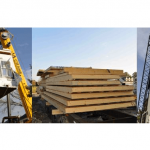How Does a Modular Home Get Assembled? – Part I: Getting Ready
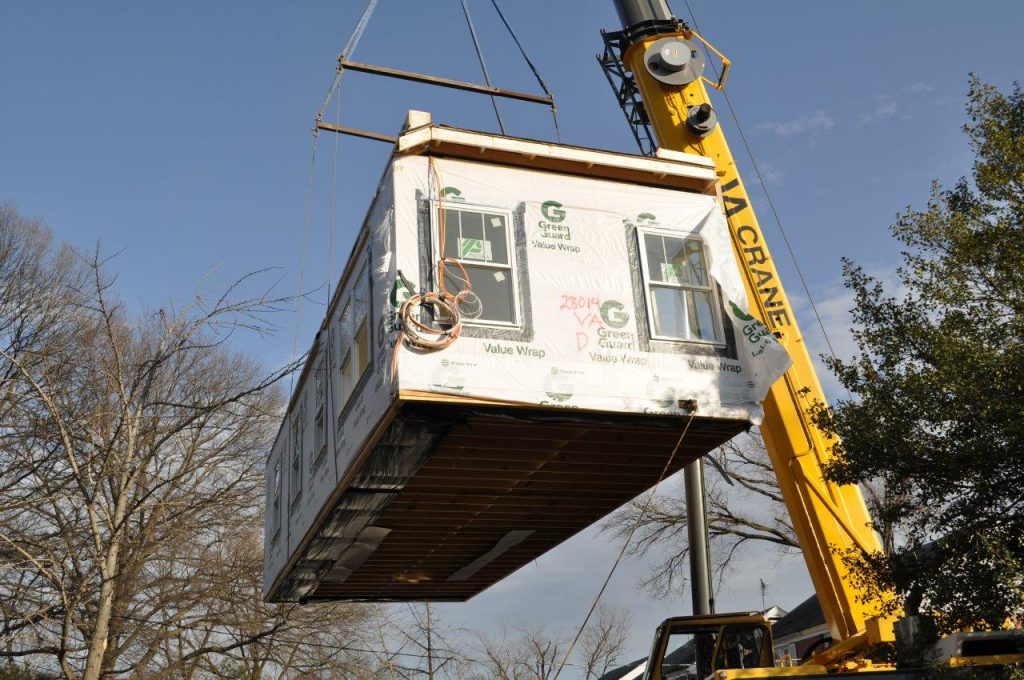

Why is Modular Home Construction a More Efficient Process?
There are many characteristics that make modular home construction attractive. From being built in a climate controlled environment, to using materials that don’t get wet, to having a better trained and consistent workforce. Another big advantage is time savings.
Because the main components of a home are being built offsite, the site excavation and construction of the foundation can be taking place at the exact same time. There is no need to wait until the foundation is done before you start building the floor of the new home. This can shave several weeks off of the overall construction process and is another key advantage to using modular construction.
Foundation/Site Work Happens Simultaneously with Construction of Your Home
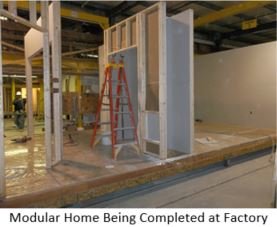
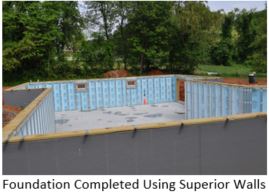
How is a Modular Home Transported to the Home Site?
Once completed in the factory the modules have to be delivered to the home site. The modules are typically put on an I-beam carrier that is specially built to protect the module from the rigors of navigating hills, bends and potholes on today’s roads. The carriers are only attached to the module temporarily during transport. In most cases, delivery is scheduled for the day immediately preceding the day of the home set. On set day, the homes modules are raised from the carrier and the carriers are stacked and returned to the factory.
 A specialty truck known as a toter pulls the carriers that support the modules as they travel to the home site. A basic toter has a fixed hitch used to pull the carriers to most sites. However, there are special toters that have the ability to move the hitches to help the truck and carrier navigate some of the sharp turns and narrow roads. These typically have a single rear axle and are very short. They work very well when transporting a modular home module through very tight locations.
A specialty truck known as a toter pulls the carriers that support the modules as they travel to the home site. A basic toter has a fixed hitch used to pull the carriers to most sites. However, there are special toters that have the ability to move the hitches to help the truck and carrier navigate some of the sharp turns and narrow roads. These typically have a single rear axle and are very short. They work very well when transporting a modular home module through very tight locations.
What does it take to set a Modular Home?
For many, the buzz and excitement of setting a modular home is much like a good old fashioned barn raising from 100 years ago. However, by using a crane, it takes a lot less people! There are essentially three ingredients needed to set a modular home: A set crew, a crane, and the actual home modules themselves. All of these take up space and all need to be on a home site at once.
Related: SO… YOU WANT TO BUILD A CUSTOM HOME
The day of the home set is a critical step in the overall home building process. Each member of this team is crucial to the successful completion of a custom modular home. Safety, communication, and coordination are key. Every aspect of setting a home depends on managing very large home modules and very heavy cranes to ultimately place a home on a foundation, usually in less than a day!
Configuring the Site
 When preparing a site that is using modular home construction, space is need to get all the required pieces onsite. This includes the modules themselves, the crane and its support truck, and the set crew truck/trailer. Also, a space for storing carriers onsite after the modules are lifted is needed.
When preparing a site that is using modular home construction, space is need to get all the required pieces onsite. This includes the modules themselves, the crane and its support truck, and the set crew truck/trailer. Also, a space for storing carriers onsite after the modules are lifted is needed.
Every site is different. When possible, it is best to place all of the homes modules near the foundation within easy reach of the crane location. Access needs to be given for the crane to be set up and for the set crew to place their tools and truck nearby for easy access throughout the day.
Rarely is every site perfect. If space isn’t available, never fear, modules can be staged offsite, cranes can be set up in advance, and carriers can be removed immediately after set to a nearby location. An experienced and knowledgeable modular home builder is used to dealing successfully with just about every site situation you can imagine.
The Module Placement
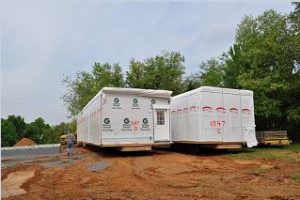 The modules themselves are large. Average modules are 14’ wide and 50’+ long. Some modules can be 16’+ wide and 76’+ long. When possible, the modules should be placed as close to the foundation without risking pushing in the backfill near the foundation. Close placement is critical because a crane can only pick up modules from a certain distance from the foundation. If modules are too far away then a bigger crane will be needed. The bigger the crane needed, the bigger the bill when you rent it. Care is always taken to configure the site to use the smallest crane possible that will safely do the job!
The modules themselves are large. Average modules are 14’ wide and 50’+ long. Some modules can be 16’+ wide and 76’+ long. When possible, the modules should be placed as close to the foundation without risking pushing in the backfill near the foundation. Close placement is critical because a crane can only pick up modules from a certain distance from the foundation. If modules are too far away then a bigger crane will be needed. The bigger the crane needed, the bigger the bill when you rent it. Care is always taken to configure the site to use the smallest crane possible that will safely do the job!
In some cases it can take 6, 8, or 10 modules to build a modular home. In those cases there just isn’t enough room around the foundation to place all of the modules. In those cases they are stored offsite and a truck brings each module as needed as the home is assembled. In some cases they can be stored elsewhere on the same site and equipment such as a dozer or loader can bring the modules to the crane as needed.
The Crane
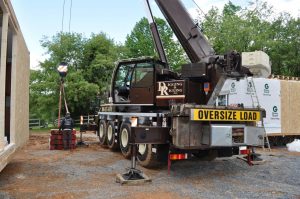 In addition to being large a home’s modules are also heavy. They can weigh from 15,000 pounds to well over 40,000 pounds. When determining the size crane needed, it just isn’t the amount of weight they are lifting but the distance they have to lift it. In many cases, the distance is determined by where the crane can be placed near the foundation.
In addition to being large a home’s modules are also heavy. They can weigh from 15,000 pounds to well over 40,000 pounds. When determining the size crane needed, it just isn’t the amount of weight they are lifting but the distance they have to lift it. In many cases, the distance is determined by where the crane can be placed near the foundation.
Cranes can be dangerous and so the crane operator has control of the job site when the crane is in operation. High winds, poor ground conditions, and other issues could cause the operator to determine that it is too dangerous to set a home on any given day. Safety is always key when lifting heavy sections of a home’s modules. Just because accidents rarely happen doesn’t mean they can’t. Always respect the crane and the job site when working at or observing a modular home set.
The Set Crew
 The modular home construction process depends on the expert assembly of modules on a home site. Set crews are typically subcontractors to modular home builders or modular home factories. They typically cover regions of the country and set a home every day of the week. The crew brings their unique tools and equipment for modular home setting with them to each home set.
The modular home construction process depends on the expert assembly of modules on a home site. Set crews are typically subcontractors to modular home builders or modular home factories. They typically cover regions of the country and set a home every day of the week. The crew brings their unique tools and equipment for modular home setting with them to each home set.
The process can be mind-boggling for many new to modular construction to watch. On many sites home owners are amazed at the fluid movement of a good set crew. They rarely talk and just know what they are supposed to do and do it. Communication with the crane operator is done through a unique sign language that directs the movement of the crane during the home set.
Now the Set Can Begin
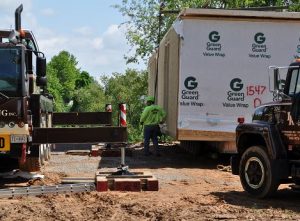 On a typical set day the set crew shows up at first light. To protect a home’s modules during transport and storage they are typically shrink wrapped in plastic and shielded with sheathing to protect from road debris and moisture. This all has to be removed prior to being set.
On a typical set day the set crew shows up at first light. To protect a home’s modules during transport and storage they are typically shrink wrapped in plastic and shielded with sheathing to protect from road debris and moisture. This all has to be removed prior to being set.
While the set crew is doing this, the crane is scheduled to arrive and begin its set up process. Weights have to be added to aid in counterbalancing the home modules weight. With a well-planned site and well-coordinated schedule, the first module will be ready to be set within 1-2 hours of first light.
This concludes Part I of this two part post. In the next post you will see the modules come together and how all of those separate modules are skillfully and quickly assembled into a home that can be as much as 75-85% complete on set day.
The post How Does a Modular Home Get Assembled? – Part I: Getting Ready appeared first on Impresa Modular.




